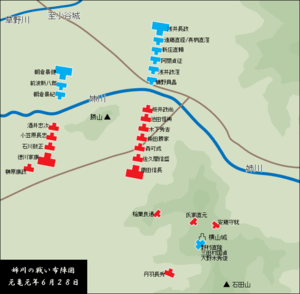Battle of Anegawa
| Battle of Anegawa | |||||||
|---|---|---|---|---|---|---|---|
| Part of Sengoku period | |||||||
 Blue:Azai (east) and Asakura (west). Red:Oda (east), Tokugawa (west) and Inaba (southeast) | |||||||
| |||||||
| Belligerents | |||||||
| forces of Oda Nobunaga, Tokugawa Ieyasu | forces of Azai Nagamasa and Asakura Yoshikage | ||||||
| Commanders and leaders | |||||||
|
Oda Nobunaga Tokugawa Ieyasu Inaba Ittetsu |
Azai Nagamasa Asakura Yoshikage | ||||||
| Strength | |||||||
| 28,000[1]:62 | 10,000[1]:62 | ||||||
The Sengoku period Battle of Anegawa (姉川の戦い Anegawa no Tatakai) (30 July 1570) occurred near Lake Biwa in Ōmi Province, Japan, between the allied forces of Oda Nobunaga and Tokugawa Ieyasu, against the combined forces of the Azai and Asakura clans. It is notable as the first battle that involved the alliance between Nobunaga and Ieyasu, liberated the Oda clan from its unbalanced alliance with the Azai, and saw Nobunaga's prodigious use of firearms. Nobunaga's loyal retainer, Toyotomi Hideyoshi was assigned to lead troops into open battle for the first time.
The battle came as a reaction to Oda Nobunaga's sieges of the castles of Odani and Yokoyama, which belonged to the Azai and Asakura clans. It was also referred to as the Battle of Nomura (野村合戦 Nomura Kassen) by the Oda and Azai clans and the Battle of Mitamura (三田村合戦 Mitamura Kassen) by the Asakura clan.
There is a battlefield memorial marker in Nomura-cho, Nagahama city, in Shiga Prefecture.[1]
Description
As warriors sallied forth from the castles, the battle turned into a melee fought in the middle of the shallow Ane River. For a time, Nobunaga's forces fought the Azai upstream, while the Tokugawa warriors fought the Asakura downstream.[2]
Ieyasu unleashed his second division under Honda Tadakatsu and Sakakibara Yasumasa onto Asakura's left flank, surrounding Asakura Kagetake.[1]:62–63
A famous duel involved Makara Jurozaemon, and his eldest son Makara Jurosaburo Naomata, who both covered the retreat of the Asakura army to the northern bank. Both were eventually killed however when confronted by four Mikawa samurai, Kosaka Shikibu, Kosaka Gorojiro, Kosaka Rokurogoro, and Yamada Muneroku, and a fifth samurai named Aoki Jozaemon.[1]:63–65
In another notable engagement, an Azai samurai named Endo Kizaemon attempted to take Nobunaga's head, but was stopped short by Takenaka Kyusaku.[2]
After the Tokugawa forces finished off the Asakura, they turned and hit the Azai right flank. Inaba Ittetsu, who had been held in reserve, then came forward and hit the Azai left flank. Many of the besiegers of Yokoyama even left their task to aid in the battle. The Azai and Asakura forces were soon defeated.[2]
It is often noted that Nobunaga used 500 arquebusiers in this battle. He was famous for his tactical use of firearms but would find himself on the opposite end of skilled arquebus tactics in his Siege of Ishiyama Hongan-ji that year.
Meanwhile, no reliable source exists to reconstruct the battle. The Battle of Anegawa is vividly presented in the books compiled in the middle or the end of the Edo period. Many of the stories are pure fiction. The only valuable source is the Shinchōkō-ki, describing it very briefly without any notes concerning tactics or details of the battle.
The exact number of the casualties in this battle is unknown. However, the Shinchōkō-ki mentions 1,100 samurai from Asakura clan being killed in battle. An army of this period had at least several times more ashigaru (commoner footmen) than samurai, so it would be reasonable to assume at least several thousand men were killed.
According to A.L. Sadler in The Life of Shogun Tokugawa Ieyasu there were 3,170 heads collected by the Oda camp. A good portion were taken by Mikawa men, the Tokugawa force. The Mikawa Fudoki gives a very real picture of the battle: the retainers fighting in groups and the decapitation of soldiers in the confused mingling of armies among the clouds of smoke and dust.
In popular culture
The battle has been featured in all games of the Samurai Warriors series. However, because Azai Nagamasa was made playable in Samurai Warriors 2, as opposed to the first game where he was a unique non-playable character, the battle had a larger significance. The battle has also fictionally appeared in revamped form in the Warriors Orochi series, in particular Warriors Orochi 3 is where its most famous revamp takes place. It also a playable battle in the video game Kessen III.
The story of the build-up to the battle and the winning tactics used by Tokugawa Ieyasu is retold in Volume 12 of the Dark Horse Comics series Path of the Assassin, titled "The Three Foot Battle". In this narrative, Hattori Hanzō consults with Takenaka Shigeharu and thus is provided with the superior tactics.
This battle is also featured in Total War: Shogun 2, as part of the historical battles with the download of Rise of the Samurai
References
- The Battle of Anegawa on Samurai-archives.com
- Sadler, A.L. (1937). The Life of Shogun Tokugawa Ieyasu. Rutland: Charles E. Tuttle Co.